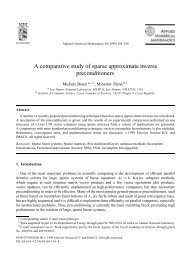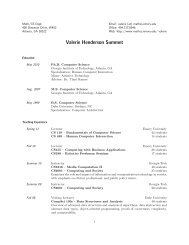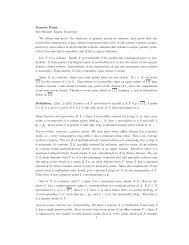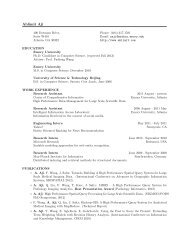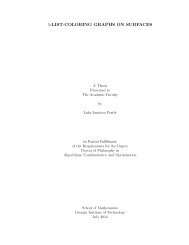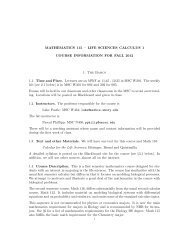Chapter 3 Solution of Linear Systems - Math/CS
Chapter 3 Solution of Linear Systems - Math/CS
Chapter 3 Solution of Linear Systems - Math/CS
You also want an ePaper? Increase the reach of your titles
YUMPU automatically turns print PDFs into web optimized ePapers that Google loves.
64 CHAPTER 3. SOLUTION OF LINEAR SYSTEMS<br />
Problem 3.3.3. Suppose<br />
⎡<br />
A = ⎣<br />
1 3 −4<br />
0 −1 5<br />
2 0 4<br />
⎤<br />
⎡<br />
⎦ and b = ⎣<br />
(a) Use Gaussian elimination without row interchanges to find the A = LU factorization.<br />
(b) Use the A = LU factorization <strong>of</strong> A to solve Ax = b.<br />
Problem 3.3.4. Suppose<br />
A =<br />
⎡<br />
⎢<br />
⎣<br />
4 8 12 −8<br />
−3 −1 1 −4<br />
1 2 −3 4<br />
2 3 2 1<br />
⎤<br />
1<br />
3<br />
2<br />
⎥<br />
⎦ and b =<br />
(a) Use Gaussian elimination without row interchanges to find the A = LU factorization.<br />
(b) Use the A = LU factorization <strong>of</strong> A to solve Ax = b.<br />
3.3.2 P A = LU Factorization<br />
As we know, the practical implementation <strong>of</strong> Gaussian elimination uses partial pivoting to determine<br />
if row interchanges are needed. In this section we show that this results in a modification <strong>of</strong> the<br />
the LU factorization. Row interchanges can by represented mathematically as multiplication by a<br />
permutation matrix. A permutation matrix is obtained by interchanging rows <strong>of</strong> the identity matrix.<br />
Example 3.3.3. Consider the matrix P obtained by switching the first and third rows <strong>of</strong> a 4 × 4<br />
identity matrix:<br />
⎡<br />
⎤<br />
⎡<br />
⎤<br />
1 0 0 0<br />
0 0 1 0<br />
⎢<br />
I = ⎢ 0 1 0 0 ⎥ switch<br />
⎢<br />
⎥<br />
⎣ 0 0 1 0 ⎦ −→ P = ⎢ 0 1 0 0 ⎥<br />
⎣ 1 0 0 0 ⎦<br />
rows 1 and 3<br />
0 0 0 1<br />
0 0 0 1<br />
Then notice that multiplying any 4 × 4 matrix on the left by P has the effect <strong>of</strong> switching its first<br />
and third rows. For example,<br />
⎡<br />
0<br />
⎢<br />
P A = ⎢ 0<br />
⎣ 1<br />
0<br />
1<br />
0<br />
1<br />
0<br />
0<br />
⎤ ⎡<br />
0 2<br />
0 ⎥ ⎢<br />
⎥ ⎢ 5<br />
0 ⎦ ⎣ 1<br />
−3<br />
2<br />
1<br />
0<br />
−4<br />
−1<br />
⎤<br />
1<br />
7 ⎥<br />
−1 ⎦<br />
0 0 0 1 0 3 8 −6<br />
=<br />
⎡<br />
1<br />
⎢ 5<br />
⎣ 2<br />
1<br />
2<br />
−3<br />
−1<br />
−4<br />
0<br />
⎤<br />
−1<br />
7 ⎥<br />
1 ⎦<br />
0 3 8 −6<br />
Suppose we apply Gaussian elimination with partial pivoting by rows to reduce a matrix A to<br />
upper triangular form. Then the matrix factorization that is computed is not an LU decomposition<br />
<strong>of</strong> A, but rather an LU decomposition <strong>of</strong> a permuted version <strong>of</strong> A. That is,<br />
P A = LU<br />
where P is a permutation matrix representing all row interchanges. It is nontrivial to derive this<br />
factorization, which is typically done in more advanced treatments <strong>of</strong> numerical linear algebra.<br />
However, finding P , L and U is not difficult. In general, we proceed as in the previous subsection<br />
for the LU factorization, but we keep track <strong>of</strong> the row swaps as follows:<br />
⎡<br />
⎤<br />
⎢<br />
⎣<br />
⎦ .<br />
3<br />
60<br />
1<br />
5<br />
⎤<br />
⎥<br />
⎦ .



